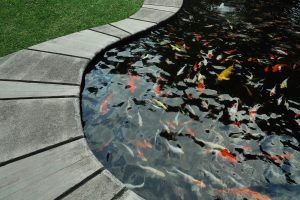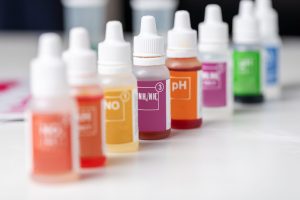
Pond De-icer for Koi Ponds: Essential Winter Care for Your Aquatic Pets
Winter can pose challenges for koi pond owners. As temperatures drop, ice forms on the surface, trapping harmful gases and blocking oxygen. This threatens the health of koi and other pond life.

Pond de-icers offer a solution to this problem. These devices keep a small area of water ice-free, allowing gas exchange and protecting fish. De-icers come in various types, from floating units to submersible models.
Choosing the right de-icer depends on pond size, climate, and specific needs. Some units include thermostats for energy efficiency, while others offer additional features like aeration. Proper use of a pond de-icer helps maintain a healthy environment for koi throughout the cold months.
Understanding Pond De-Icers
Pond de-icers are vital tools for maintaining koi ponds in winter. They prevent ice formation, allowing gas exchange and protecting fish health. Proper selection and use of de-icers is key for koi survival in cold climates.
Criteria for Selecting a Pond De-Icer
Pond size is a crucial factor when choosing a de-icer. Larger ponds need more powerful units or multiple devices. Wattage matters too – higher wattage models work faster but use more energy.
Safety features are essential. Look for de-icers with automatic shut-off to prevent overheating. Thermostat controls help save energy by turning off when not needed.
Durability is important for long-term use. Stainless steel or sturdy plastic housings resist corrosion and damage. Check warranty periods as an indicator of quality.
Energy efficiency can save money over time. Some models use less power while still keeping water open. Compare running costs when making a choice.
Different Types of De-Icers
Floating pond de-icers sit on the water surface. They’re easy to install and remove. These work well for smaller ponds or as backup devices.
Submersible de-icers rest on the pond bottom. They’re less visible and can be more effective in deeper water. Some models include built-in aeration systems.
Combination units offer both heating and aeration. These promote gas exchange and can be more efficient overall. They’re ideal for ponds with high fish populations.
De-icers with adjustable thermostats allow fine-tuning for your pond’s needs. This feature helps maintain optimal temperatures while saving energy.
Some advanced models connect to smart home systems. This allows remote monitoring and control of pond conditions.
The Importance of Temperature Control

Koi and goldfish health relies heavily on proper water temperature. Maintaining the right conditions helps these fish thrive and stay active year-round.
How Temperature Affects Koi and Goldfish
Cold water slows down koi and goldfish metabolism. When temperatures drop too low, the fish become less active and eat less. This makes them weak and prone to illness.
Very cold water can be deadly. It can cause the fish’s blood to thicken, leading to organ failure. Sudden temperature changes are also harmful. They stress the fish and weaken their immune systems.
Warm water has its own risks. It holds less oxygen, which can suffocate the fish. High temperatures also speed up metabolism, increasing the need for food and oxygen.
Optimum Temperatures for Koi Ponds
Koi and goldfish do best in water between 15-25°C (59-77°F). In this range, they stay active and healthy. Their digestion works well, and they grow steadily.
In winter, aim to keep the water above 4°C (39°F). This prevents freezing and keeps the fish’s metabolism from slowing too much. A de-icer can help maintain this minimum temperature.
During summer, shade and aeration can prevent overheating. If temperatures rise above 30°C (86°F), the fish may need extra care. Add oxygen to the water and feed them less to reduce stress.
Types of Pond Heaters and De-Icers

Pond heaters and de-icers come in two main types: floating and submersible. Each type has its own advantages for keeping koi ponds ice-free during winter.
Floating Pond De-Icers
Floating de-icers sit on the water’s surface. They create a small ice-free area to allow gas exchange. These units are easy to install and remove. Most floating de-icers use between 100-300 watts of power.
Some models have thermostats to save energy. They turn on only when temperatures drop near freezing. Laguna PowerHeat floating de-icers are popular choices for koi ponds. They come in different wattages to suit various pond sizes.
Floating de-icers work well for mild winters. They may not be powerful enough for very cold climates. In severe cold, they can get frozen into the ice.
Submersible Pond Heaters
Submersible heaters go underwater in the pond. They warm a larger volume of water than floating units. This helps maintain more stable temperatures.
These heaters often use 300-1500 watts or more. Higher wattage models can keep larger areas ice-free. Some submersible heaters have built-in pumps to circulate warm water.
Submersible units need to be placed carefully. They shouldn’t touch pond liners or be too close to fish. Many koi keepers use them in deeper areas of the pond.
These heaters are more powerful than floating types. They work better in colder regions. But they use more electricity and can be trickier to install.
Features of Effective Pond De-Icers
Pond de-icers keep koi ponds from freezing over in winter. The best models have key features that ensure they work well and keep fish safe.
Thermostatic Control
Thermostatic control helps pond de-icers run efficiently. These devices turn on only when needed, saving energy. They check the water temperature and start heating when it drops near freezing.
Most thermostat-controlled de-icers switch on at about 4°C. This keeps a small area of the pond ice-free. Fish can then get oxygen at the surface.
Some models let users set custom temperatures. This is handy for ponds with fish that need warmer water.
Heating Elements
The heating element is the core of a pond de-icer. It warms the water to prevent ice. Most use electric resistance heating.
A common type is the 315-watt floating pond heater. It sits on the water’s surface, creating a warm spot.
Heating elements come in different shapes. Some are flat discs, while others are long and tubular. The shape affects how heat spreads in the water.
Sturdy materials like stainless steel or titanium are best for heating elements. They resist corrosion from constant water contact.
Maintaining Adequate Oxygen Levels
Proper oxygen levels are vital for koi health in winter. Ensuring good gas exchange helps remove harmful gases and keeps fish thriving when ponds freeze over.
Aeration vs. Heating
Aeration and heating serve different roles in winter pond care. Aerators add oxygen by creating water movement and surface agitation. This helps gases escape and allows fresh oxygen to enter the water. Heaters, on the other hand, warm the water and prevent ice formation.
For optimal results, use both methods together. An aerator placed near the surface creates a small ice-free area. This allows for continued gas exchange even in freezing temperatures. A heater can expand this open area, further improving oxygen levels.
Floating de-icers work well with aerators. They melt a small hole in the ice around themselves. This creates a breathing space for fish and allows toxic gases to escape.
Creating a Breathing Hole
A breathing hole is crucial when ponds freeze over. It allows oxygen to enter and harmful gases to exit. Without one, fish can suffocate under the ice.
To make a breathing hole:
- Use a floating de-icer or pond heater
- Install an aerator near the surface
- Manually clear snow from a small area of ice
Never break the ice with force. The shock waves can harm or kill fish. Instead, melt a hole using warm water or a safe heating device.
Keep the breathing hole clear of snow. Snow blocks light and stops oxygen production by plants under the ice. Gently brush snow away to maintain gas exchange.
Preventing Ice Formation in Koi Ponds
Keeping koi ponds ice-free is crucial for the health of fish and plants. Proper techniques and equipment can maintain open water even in freezing temperatures.
Strategies for Ice Prevention
Pond depth plays a key role in ice prevention. Deeper ponds freeze less easily than shallow ones. Aim for at least 90 cm depth in cold regions. Adding a pond cover can trap heat and slow ice formation.
Circulation is vital. Use pumps and waterfalls to keep water moving. This makes it harder for ice to form. Place aerators near the surface to create bubbles and movement.
Remove fallen leaves and debris regularly. These can sink and decay, using up oxygen fish need in winter.
Consider adding a greenhouse or clear plastic dome over smaller ponds. This creates a warmer microclimate and blocks cold winds.
Reliable De-Icing Products
Pond de-icers are essential tools for winter pond care. The Laguna PowerHeat Heated De-icer is a popular choice. It floats on the surface and keeps a small area ice-free.
Submersible heaters work well for smaller ponds. Place them near the surface for best results. Choose models with built-in thermostats to save energy.
For larger ponds, consider a combination of methods. Use a floating de-icer plus an aerator for maximum effect.
Look for energy-efficient models to keep running costs down. Some de-icers use as little as 100 watts of power.
Always follow safety guidelines when using electrical equipment near water. Ensure all devices are properly earthed and protected from moisture.
Additional Features and Accessories
Modern pond de-icers come with helpful extras to make winter care easier. These features boost safety and efficiency for koi ponds.
LED Lights and Visual Indicators
Many pond heaters now include LED lights. These bright indicators show when the device is on and working properly. Some models use different colours to signal various functions. Red might mean the heater is active, while green shows it’s in standby mode.
LED lights also help pond owners spot the de-icer at night. This is useful for checking on the pond after dark. Some floating pond heaters have lights that shine into the water. These create a pretty glow and let you see your koi even in winter.
Energy-Efficiency Considerations
Saving energy is a top concern for pond owners. Many new de-icers have smart features to cut power use. Thermostat controls turn the heater on only when needed. This stops the device from running all the time.
Some pond heaters use low-wattage designs. These units warm the water slowly but use less electricity. Timer functions let you set when the de-icer runs. This helps manage energy costs during peak hours.
Insulated cords and bodies on de-icers also boost efficiency. They keep heat in the water instead of losing it to the air. Look for models with good ratings for energy use to save money on winter pond care.
Installation and Safety Tips
Setting up a pond de-icer properly is key for keeping koi safe in winter. Following safety steps helps avoid risks.
Correct Installation Techniques
Choose a spot near the pond’s edge for easy access. For floating de-icers, secure the power cord to prevent it from falling in. Attach the cord to a stake or weight on land.
Submersible de-icers work best in shallow areas. Place them on a flat surface like a brick to keep them stable. Make sure the heating element isn’t touching the pond liner.
For both types, use a ground fault circuit interrupter (GFCI) outlet. This cuts power if there’s a fault. Check that the cord reaches the outlet without stretching.
Set up the de-icer before the first frost. This makes installation easier and safer. Test it to ensure it’s working properly before cold weather hits.
Safety Precautions
Always unplug the de-icer before handling it. Wear rubber gloves when touching the device or cord. This protects against electric shock.
Keep the area around the pond clear of snow and ice. This reduces slip hazards when checking on the de-icer.
Check the cord regularly for wear or damage. Replace the de-icer if you spot any issues. Don’t try to repair it yourself.
Never use extension cords with pond de-icers. They can overheat and cause fires. Make sure the power cord is the right length for your setup.
Remove the de-icer when spring arrives. Clean it and store it in a dry place for next winter. This helps the device last longer and work safely year after year.
Related Posts
- Garden Pond Design Tips and Ideas for Creating a Serene Outdoor Oasis
- Common Koi Fish Diseases to Look Out for in Garden Ponds: Essential Guide for Pond Owners
- How Often Do You Need to Change Pond Filter UV Bulbs for Optimal Performance?
- Oase ProfiClear Premium Compact-L EGC: Advanced Filtration for Crystal-Clear Ponds
- Golden Rudd Care in a Pond: Essential Tips for Thriving Aquatic Pets
- Box Welded Pond Liners: The Ultimate Solution for Durable Water Containment
- Oase BioTec ScreenMatic² Filter: The Ultimate Solution for Efficient Pond Filtration
- The Best Koi Pond Liner Materials, And The Worst Choices for Durability and Aesthetics



